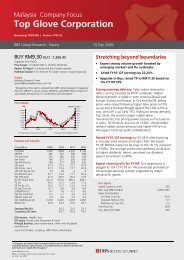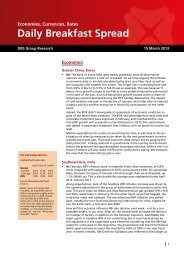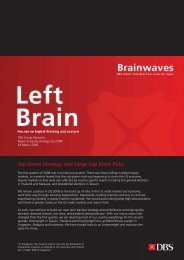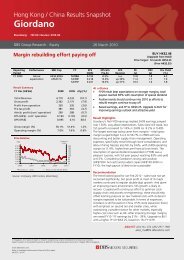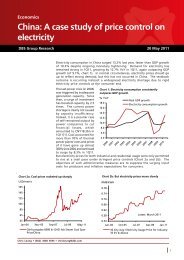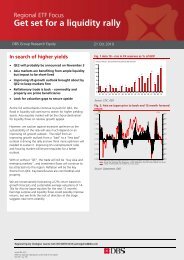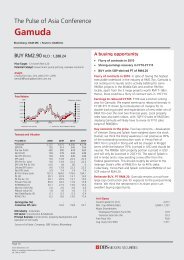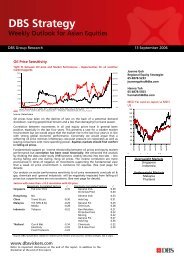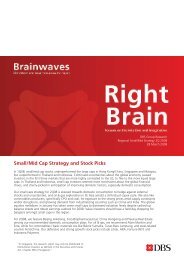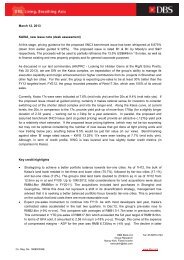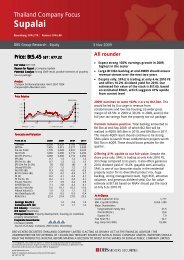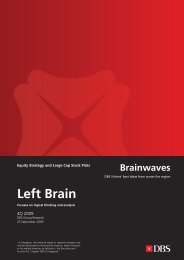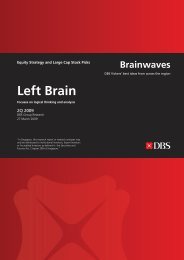Economics Markets Strategy - the DBS Vickers Securities Equities ...
Economics Markets Strategy - the DBS Vickers Securities Equities ...
Economics Markets Strategy - the DBS Vickers Securities Equities ...
Create successful ePaper yourself
Turn your PDF publications into a flip-book with our unique Google optimized e-Paper software.
<strong>Economics</strong> – <strong>Markets</strong> – <strong>Strategy</strong><br />
Asian Equity <strong>Strategy</strong><br />
Country asset allocation recommendations and<br />
changes<br />
Overweight markets: China-H, Taiwan, Singapore<br />
Underweight markets: Malaysia, India, Thailand,<br />
Indonesia<br />
Neutral markets: Hong Kong, Korea<br />
Singapore: Upgrade to Overweight from Benchmarkweight<br />
Singapore remains <strong>the</strong> cheapest market in <strong>the</strong> region,<br />
based on <strong>the</strong> number of standard deviation away<br />
from historical average of consensus 12-month forward<br />
P/E (see Fig. 15). There was a lot of uncertainty in<br />
<strong>the</strong> 'E', specifically fear of more downgrades, but<br />
that has been largely priced in. Consensus now<br />
expects negative earnings growth for 2008 instead<br />
of 4% growth early this year, and 10% in September.<br />
1Q08 results were mixed but generally met expectations.<br />
Fig. 15: Regional markets' 12m fwd P/E: No. of standard<br />
deviation away from average - Singapore is <strong>the</strong> cheapest<br />
market based on historical trend<br />
Singapore<br />
Taiwan<br />
Malaysia<br />
Thailand<br />
Indonesia<br />
AXJ<br />
Korea<br />
China 'H'<br />
Hong Kong<br />
India<br />
-1.5 -1.0 -0.5 0.0 0.5 1.0 1.5<br />
Cheap<br />
Expensive<br />
Source: Datastream, Bloomberg, <strong>DBS</strong> calculations. Average<br />
and standard deviations from 1993 - present.<br />
Going forward we expect <strong>the</strong> Singapore economy<br />
to experience a modest slowdown y-o-y in 2Q and<br />
3Q before recovering in <strong>the</strong> 4Q. Engines of growth<br />
should remain in services and construction, refinery<br />
and offshore marine sectors.<br />
Inflation should come off in <strong>the</strong> next few months<br />
as year-on-year effect of <strong>the</strong> GST hikes in July last<br />
year diminish. However price level should remain<br />
elevated and continue to hurt consumer spending.<br />
The moderation in <strong>the</strong> GDP we expected is in private<br />
consumption. While high inflation will slow private<br />
spending, we believe <strong>the</strong> strong reserves and social<br />
fiscal balance will be a safety net for <strong>the</strong> needy<br />
Fig. 16: Singapore earnings growth downgraded<br />
20<br />
15<br />
10<br />
5<br />
0<br />
-5<br />
-10<br />
%<br />
2009 earnings<br />
growth<br />
2008 earnings<br />
growth<br />
Feb-06 Jul-06 Dec-06 May-07 Oct-07 Mar-08<br />
Source: IBES, <strong>DBS</strong> calculations<br />
and less of a social concern for Singapore.<br />
The impact of macro changes on Singapore equities<br />
should be minimal in our view, and selective on<br />
sectors that are sensitive to such changes. We now<br />
forecast higher bond yields with a flattening yield<br />
curve and a stronger USD.<br />
Singapore bond yields have risen in recent weeks<br />
in tandem with US bond yields. Recently, an extraordinary<br />
case of poor auction response to Singapore 10-<br />
year treasury bonds lifted yields by 100bps. With<br />
our new US Fed funds forecast (50bps hikes in 4Q08<br />
and 75bps in 1Q09) we expect <strong>the</strong> Singapore long<br />
bond yields to rise ano<strong>the</strong>r 50bps by year end and<br />
35bps in 1Q09, taking bond yields from 3.4% currently<br />
to 4.15%. Among stocks under our coverage, 48%<br />
of <strong>the</strong>m are offering more than 3.4% dividend<br />
yield, and 40% more than 4.15%. But investing<br />
for dividends may not be an appropriate strategy<br />
in a rising bond yield environment.<br />
We expect <strong>the</strong> USD to streng<strong>the</strong>n as <strong>the</strong> Fed easing<br />
Fig. 17: Singapore exchange and interest rates<br />
forecasts<br />
(% )<br />
Fed<br />
funds<br />
3m<br />
SIBOR<br />
12m<br />
SIBOR<br />
SGS<br />
2Y<br />
SGS<br />
10Y<br />
SGD /<br />
USD<br />
current 2.00 1.36 1.91 1.24 3.64 1.37<br />
3Q08 2.00 1.31 2.06 1.60 3.80 1.38<br />
4Q08 2.50 1.52 2.27 2.22 3.90 1.40<br />
1Q09 3.25 1.94 2.69 2.40 3.93 1.42<br />
2Q09 4.00 2.31 2.81 2.65 4.04 1.44<br />
3Q09 4.50 2.67 3.02 2.66 3.92 1.42<br />
4Q09 4.50 2.64 2.89 2.42 3.79 1.40<br />
Source: <strong>DBS</strong><br />
63



